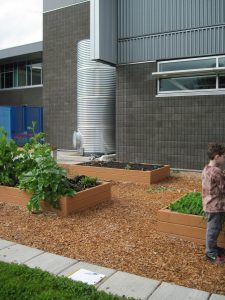It looks like the school garden concept is getting some serious respect from the 4J school district.
Just look at the spanking new Howard Elementary School where, in a first for 4J, a raised bed garden was incorporated in the school’s landscape design right from the start, and it shows. Next to the garden there’s a big, beautiful water collection tower, one of several cool features at this school relating to rain water. And the new River Road Elementary now under construction will be the second school to include a garden as an integral component of the plan.
I recently visited both schools to observe the School Garden Project of Lane County (SGP) at work. John Moriarty, director of the program, says the SGP currently operates in-school programs at 17 schools. One grade per school, two to four sections per grade, each receives 10 sessions per year. In addition to these core in-school programs, SGP provides three after-school programs that operate through BEST (Boosting and Enriching Students Today), a 4J program that offers academic support and enrichment classes for students in need.
I’ve watched two of SGP’s four teachers in action, and I‘m very impressed. At River Road Elementary School, I observed a 4th grade class led by Lucy Miner, who came to SGP a few months ago with a wealth of experience in education. This was her first session with the class since fall, and I was struck with her ability to hold the attention of her young students as she asked them to think back to an experiment they set up in their temporary garden last fall, explained what they would be doing in the garden if the rain held off (it did) and delivered a brief refresher about how to behave outside.
Once in the garden, Miner and two volunteers guided the students through discussion of their erosion experiment, inquiry into all the things plants need to grow and a tasting session. A certain amount of incidental discovery occurred along the way: “Look, I’ve found a centipede!” “There’s a big worm!” Someone proudly showed off a sprouted hazelnut with a root and four baby leaves.
School gardens present a great opportunity to introduce kids to vegetables they may not be familiar with, and studies show students are five times more likely to try vegetables if they grew them themselves, and more likely to accept similar foods outside of school. At Howard, where rain kept Sarah Wheeler’s delightful BEST class of 1st and 2nd graders indoors for a while, we played fun and instructive plant games and made popcorn. When we eventually got out to the garden, Wheeler was delighted when a kid who previously had insisted he hated vegetables tried mustard, lettuce and pea leaves.
In addition to its core activities, SGP offers a support program that provides seeds, starts and consultation to 25 gardens, most of them in schools. The SGP curriculum is also available online, and Moriarty tells me it’s been downloaded in 47 states. Curriculum-wise, SGP is ahead of the curve. In line with their goal of offering a strong program that meshes well with the needs of teachers, SGP elected in 2014 to direct class development towards the Next Generation Science standards that will be in effect beginning 2018.
Teachers like the program, Moriarty says, and to a large extent it is teachers who create the demand for SGP’s services. That shows SGP is doing a good job, right? “Partly, yes, success is reflected in demand for our program,” he says. “But we also do assessment. We hand out pre- and post-participation work sheets that look for increased knowledge (90-95 percent of students demonstrate increased knowledge of the subject matter) and before-and-after assessment of vegetable preference.”
Last fall, 68 percent of students reported liking veggies better!
I ask Moriarty if he’s planning to take on more schools. “We don’t approach schools,” he tells me. “They come to us, and currently we have more demand than we can meet.” What are the limits to growth? I ask. “Money, really, most of which goes to pay our staff,” he responds. “Educators are the single biggest item, but we could use more office assistance and we really need a development person.” Schools pay fees for SGP’s services on a sliding scale, but they cover only 8-10 percent of costs. SGP must secure the rest from outside sources. Fundraising currently falls primarily to the director.
When I ask why he thinks school garden education is important, Moriarty responds, “It’s strategic. This single, fairly low-cost educational activity delivers multiple benefits, including increased science knowledge; new gardening skills; understanding and respect for the natural world; and a greater affinity for eating vegetables. It’s a lot of bang for the buck.”

The water silo at Howard Elementary. Howard also has a striking water feature: a very tall, open steel tower through which water tumbles when it’s raining, falling into a rock stream bed and soak-away. Beneath the school there are tanks that store rain water, which is used to flush the school’s toilets.